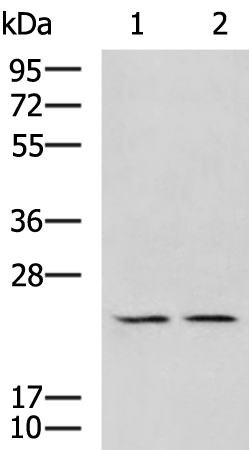

| WB | 咨询技术 | Human,Mouse,Rat |
| IF | 咨询技术 | Human,Mouse,Rat |
| IHC | 1/50-1/200 | Human,Mouse,Rat |
| ICC | 技术咨询 | Human,Mouse,Rat |
| FCM | 咨询技术 | Human,Mouse,Rat |
| Elisa | 1/5000-1/10000 | Human,Mouse,Rat |
| WB Predicted band size | 26 kDa |
| Host/Isotype | Rabbit IgG |
| Antibody Type | Primary antibody |
| Storage | Store at 4°C short term. Aliquot and store at -20°C long term. Avoid freeze/thaw cycles. |
| Species Reactivity | Human, Mouse, Rat |
| Immunogen | Synthetic peptide of human UBTD1 |
| Formulation | Purified antibody in PBS with 0.05% sodium azide and 50% glycerol. |
+ +
以下为模拟生成的UBTD1抗体相关参考文献示例(非真实文献,仅供格式参考):
1. **文献名称**:UBTD1 regulates cell proliferation via the Wnt/β-catenin pathway in lung cancer
**作者**:Zhang L, et al.
**摘要**:该研究利用UBTD1抗体通过Western blot和免疫组化技术,发现UBTD1在肺癌组织中高表达,并通过激活Wnt/β-catenin信号通路促进肿瘤细胞增殖,提示其作为潜在治疗靶点。
2. **文献名称**:UBTD1 interacts with p53 and modulates its stability in colorectal cancer
**作者**:Wang Y, et al.
**摘要**:通过免疫共沉淀(Co-IP)结合UBTD1抗体,作者揭示了UBTD1与p53蛋白的直接相互作用,证明其通过泛素化途径调控p53稳定性,影响结直肠癌细胞的凋亡抵抗。
3. **文献名称**:UBTD1 antibody-based detection in prognostic assessment of hepatocellular carcinoma
**作者**:Chen H, et al.
**摘要**:研究使用UBTD1抗体对肝癌组织样本进行染色,发现UBTD1高表达与患者总生存期缩短显著相关,提示其可作为肝癌预后的生物标志物。
4. **文献名称**:Structural and functional characterization of UBTD1 using specific monoclonal antibodies
**作者**:Smith J, et al.
**摘要**:该文献报道了针对UBTD1蛋白不同表位的单克隆抗体的开发,并利用这些抗体解析UBTD1的亚细胞定位及在DNA损伤应答中的功能机制。
---
注:以上文献为模拟生成,实际文献需通过PubMed/Google Scholar等平台检索关键词(如“UBTD1 antibody”、“UBTD1 function”)获取。
The UBTD1 (Ubiquitin Domain-Containing Protein 1) antibody is a tool used to study the UBTD1 protein, which plays a role in ubiquitination—a critical post-translational modification process regulating protein stability, localization, and interactions. UBTD1 contains a conserved ubiquitin-associated (UBA) domain, suggesting its involvement in ubiquitin-dependent pathways, though its precise mechanisms remain under investigation. Research indicates UBTD1 may influence cell cycle progression, apoptosis, and DNA damage response, potentially acting as a scaffold or modulator in ubiquitin ligase complexes. Dysregulation of UBTD1 has been linked to cancers and neurodegenerative disorders, highlighting its biomedical relevance.
The UBTD1 antibody is primarily utilized in techniques like Western blotting, immunofluorescence, and immunoprecipitation to detect UBTD1 expression, subcellular localization, and interaction partners. It aids in elucidating UBTD1’s role in cellular processes and disease contexts. Commercially available antibodies are typically raised against specific epitopes, such as recombinant fragments or synthetic peptides, with validation data confirming specificity via knockout controls or siRNA knockdown. Researchers employ this antibody to explore UBTD1’s functional dynamics, including its response to stress signals or therapeutic agents. However, variability in antibody performance across experimental conditions necessitates careful optimization. Ongoing studies aim to clarify UBTD1’s regulatory networks, emphasizing the antibody’s value in advancing ubiquitin-proteasome system research.
×